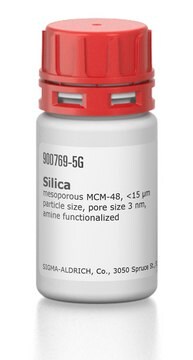938181
Sílice
hollow nanoparticles, 1000 nm particle size, pore size 40 Å
Sinónimos:
Dióxido de silicio
About This Item
Productos recomendados
Nivel de calidad
Formulario
powder
tamaño de partícula
1000 nm
tamaño de poro
40 Å pore size
bp
2230 °C (lit.)
mp
>1600 °C (lit.)
cadena SMILES
O=[Si]=O
InChI
1S/O2Si/c1-3-2
Clave InChI
VYPSYNLAJGMNEJ-UHFFFAOYSA-N
¿Está buscando productos similares? Visita Guía de comparación de productos
Categorías relacionadas
Descripción general
Aplicación
Código de clase de almacenamiento
11 - Combustible Solids
Clase de riesgo para el agua (WGK)
nwg
Punto de inflamabilidad (°F)
Not applicable
Punto de inflamabilidad (°C)
Not applicable
Elija entre una de las versiones más recientes:
Certificados de análisis (COA)
Lo sentimos, en este momento no disponemos de COAs para este producto en línea.
Si necesita más asistencia, póngase en contacto con Atención al cliente
¿Ya tiene este producto?
Encuentre la documentación para los productos que ha comprado recientemente en la Biblioteca de documentos.
Nuestro equipo de científicos tiene experiencia en todas las áreas de investigación: Ciencias de la vida, Ciencia de los materiales, Síntesis química, Cromatografía, Analítica y muchas otras.
Póngase en contacto con el Servicio técnico
